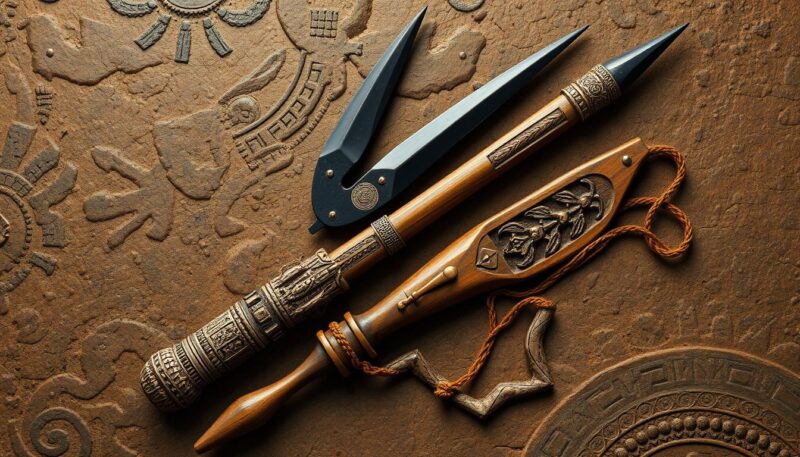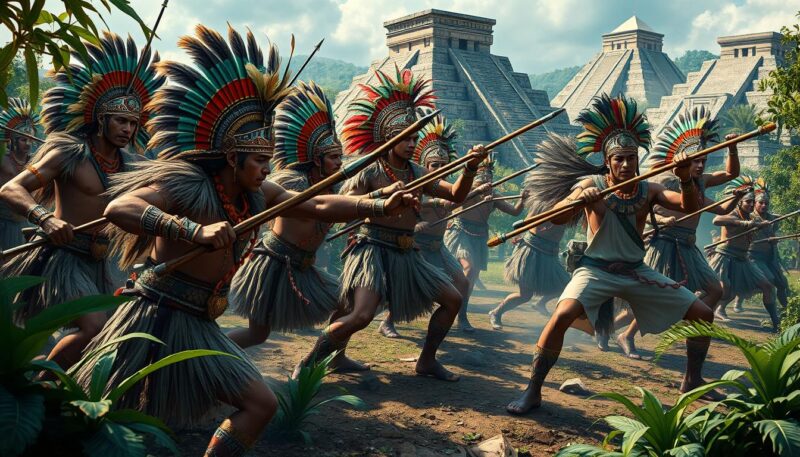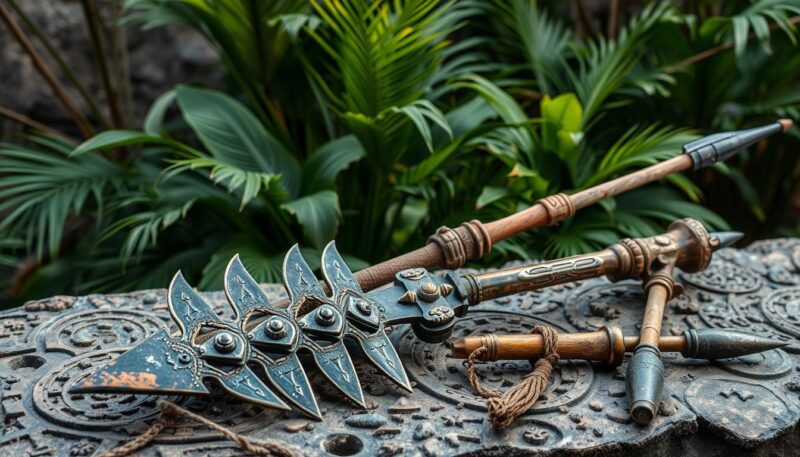The ancient Aztecs, known for their powerful empire and rich cultural heritage, wielded a variety of innovative weapons in their encounters with Spanish conquistadors. This complex society not only developed a unique array of fighting tools but also integrated warfare deeply into their culture, worldview, and societal structure. As we delve into the arsenal of the Aztec warriors, we will explore crucial pieces of equipment such as the macuahuitl, a formidable obsidian-edged sword, and the atlatl, a spear thrower that greatly extended the range and impact of their projectiles. Each weapon was thoughtfully designed for specific purposes on the battlefield, with indigenous warriors utilizing these tools not only for survival but to uphold their cultural practices during the tumultuous times of the Spanish conquest. Understanding these ancient Aztec weapons provides profound insight into the civilization’s military tactics and reveals the significance of warfare in Aztec society.
Overview of Aztec Warfare and Society
Warfare was a cornerstone of Aztec civilization, deeply woven into its cultural tapestry. Engaging in battles served multiple purposes, including territorial expansion, resource acquisition, and fulfilling religious obligations through the capture of prisoners for sacrifice. The Aztecs maintained a unique social structure around military service, creating a strong emphasis on military training for all boys and men, ensuring a near 100% participation rate within the male population.
The Role of Warfare in Aztec Culture
Warfare in the Aztec Empire was not merely a means of conflict; it held significant cultural weight. Victorious warriors earned prestige and moved up the rigid societal ranks, with success directly impacting their position. The pursuit of honor through battle influenced the Aztec war tactics employed, prioritizing strategies that maximized the capture of prisoners rather than outright slaughter. Flower Wars, a ritualized form of conflict, exemplified this approach as combatants sought to capture enemies for sacrificial purposes, emphasizing the intertwining of spirituality and military objectives.
Military Hierarchy and Ranks
The hierarchy within the Aztec military was meticulously organized, characterized by defined ranks that clarified warriors’ roles and authority. Successful warriors were awarded various military ranks based on their achievements:
| Rank | Requirements | Status |
|---|---|---|
| Tlamani | Capture of 1 enemy | Basic warrior rank |
| Cuextecatl | Capture of 2 enemies | Intermediate rank |
| Papalotl | Capture of 3 enemies | Advanced rank |
| Cuauhocelotl | Capture of 4 or more enemies | Elite rank (Eagle and Jaguar knights) |
Commoners achieving the rank of Eagle or Jaguar knight attained noble status, accompanied by privileges such as land ownership and exclusive access to certain resources. The Otomies and Shorn Ones represented the highest echelons of military society reserved for the nobility, showcasing a stark division based on class. The Shorn Ones, recognized for their distinctive hairstyles and shock troop duties, played an integral role in shaping Tenochtitlán warfare, underscoring the importance of elite forces in the Aztec military framework.
Ancient Aztec Weapons Used in Battles
The Aztec civilization showcased a remarkable arsenal of weapons specifically designed for their military needs. The weaponry can be categorized into two main classes: projectile weapons and melee weapons. Each type played a critical role in the success of Aztec warriors on the battlefield.
Projectile Weapons
Among the most notable projectile weapons was the atlatl spear thrower. This ingenious device extended a warrior’s range and significantly increased the velocity of thrown projectiles. Darts launched from the atlatl could achieve considerable distances, often exceeding 600 feet. The lethal combination of speed and distance made it a formidable weapon.
Aztec bows, known as tlahuitolli, measured about 5 feet long. These bows fired arrows that could travel distances of over 450 feet. The arrows were typically tipped with obsidian blades, enhancing their effectiveness against both cotton armor and, on occasion, the steel armors of the Spanish.
Spears like the tepoztopilli, averaging around 7 feet in length, featured wide heads with obsidian edges. This design allowed them to pierce through metal armor, as noted by Spanish accounts. The combination of the atlatl, bows, and spears provided Aztec warriors with various options for ranged combat, allowing for tactical flexibility on the battlefield.
Melee Weapons
Melee combat was dominated by a variety of formidable weapons. The macuahuitl obsidian sword stood out due to its lethal capabilities. Ranging from 3 to 4 feet, this sword featured sharp obsidian edges that could easily decapitate a man or slice through the body of a horse. Such effectiveness made it a feared weapon among adversaries.
Aztec war clubs came in several forms, including the cuauhhololli, designed for crushing, and the huitzauhqui, which had sharpened stones embedded for added lethality. These clubs were made for close-quarters combat and exemplified the diverse strategies employed by Aztec warriors.
To complement their offensive capabilities, Aztec shields and armor were essential for protection. Handcrafted from wood and often decorated with distinct designs, the shields allowed warriors to defend against blows as well as strike opponents. The ichcahuipilli body armor, made from layered cotton, effectively shielded warriors from Mesoamerican weaponry and even some European arms.

Aztec Military Tactics and Strategies against the Spanish
Aztec military tactics reflected a sophisticated understanding of warfare that emphasized strategy over brute force. Their planning involved capturing prisoners for ritual sacrifice rather than simply killing enemies. This approach was fundamental in shaping their battle formations and ambush strategies, which provided them an edge against the heavily armed Spanish soldiers. With their knowledge of the terrain and coordinated group movements, the Aztecs maneuvered skillfully, often outpacing their adversaries despite the technological disparities.
Battlefield Strategies
The Aztecs employed various battlefield strategies to optimize their chances against Spanish forces. Key tactics included:
- Ambushes: Utilizing the element of surprise, Aztec warriors would launch sudden attacks on unsuspecting Spanish units.
- Terrain Advantage: Familiarity with the local landscapes allowed the Aztecs to engage in guerrilla-style warfare, leveraging natural cover to conceal their maneuvers.
- Scouting: Aztec scouts, easily recognizable by their yellow face paint and conch-shell trumpets, provided critical information about enemy movements, allowing for tactical adjustments on the battlefield.
- Concentration of Forces: During major campaigns, the Aztecs mobilized large numbers of warriors, often up to 200,000, organized into well-coordinated divisions to overwhelm opponents.
Comparing Aztec and Spanish Weapons
The comparison of Aztec vs Spanish weapons highlights the distinct approaches to armament between the two cultures. The Aztecs utilized a variety of weapons, including:
| Type | Aztec Weapons | Spanish Weapons |
|---|---|---|
| Clubs | Macuahuitl, featuring obsidian blades | Steel swords |
| Ranged | Bows and atlatls | Crossbows and early firearms |
| Body Armor | Ichcahuipilli (quilted cotton) | Metal armor |
| Shield | Wooden shields with fabric coverings | Steel shields |
The Aztec battle strategies focused on maximizing their armed forces’ efficiency and adapting their warfare methods to counter the technological advancements of the Spanish conquistadors. By utilizing their environment and emphasizing individual prowess, they sought to maintain their power and control over their empire during these turbulent times.

Conclusion
The use of ancient Aztec weapons was a defining aspect of the fierce resistance the Aztecs mounted against Spanish conquest weapons during the early 16th century. Aztec warriors, known for their discipline and martial skill, utilized a diverse arsenal of weaponry that not only served tactical purposes but also embodied their rich cultural identity. The complexities inherent in their warfare illustrate a society where combat played a central role in both survival and religious practices, emphasizing the significant impact of these indigenous warriors on history.
Throughout the tumultuous period marked by the Spanish invasion, the Aztecs leveraged their unique military strategies and the effectiveness of their weaponry, from the deadly macuahuitl to the strategic use of projectile weapons. The discipline ingrained in Aztec military hierarchy ensured that even in overwhelming odds, their resolve and combat proficiency shone through, as evidenced during pivotal encounters such as the Battle of Otumba.
Ultimately, the legacy of ancient Aztec weapons reflects more than mere tools of warfare; they symbolize a vibrant culture that resisted and fought valiantly against formidable invaders. Understanding the significance of these weapons enhances our comprehension of the historical narrative surrounding the Aztec Empire and its enduring influence long after the devastation of their capital, Tenochtitlán.

